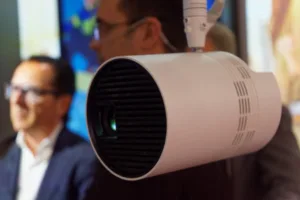Panasonic had a re-located booth this time – it was said to be bigger than last year’s. There was an impressive demo of projection mapping onto a Tesla and we made a short video of it.
We met up with Enrique Robledo to look around the flat panel products. Panasonic has a new software platform that was being demonstrated at the show and will be introduced across the product range over the financial year. The sets will have embedded players which can run a full Android system or render HTML5. This means, Robledo told us, that the company can support “any CMS” and the firm is testing with Scala, BroadSign and others at the show.
In developing its latest LCD sets, now that PDP has gone, the firm has been careful to ensure that the “fit, form and function” and industrial design is similar between the latest LCDs and the previous generation of PDPs so that integrators can use existing fittings and mountings etc. The LCD models also have some of the same features such as 3G-SDI options for use in broadcast environments.
There are three new series, the LF80s (42″, 49″ and 55″) with 700 cd/m², the LF8 (42″, 49″ and 55″) with 500 cd/m² and the entry level LFE8 (43″, 48″, 55″, 65″) range with 350 cd/m². The LF80 and LF8 ranges use IPS panels and support 24/7 operation; while all the panels use direct LED backlights. Bezel width is 6.5mm on the LF80 and LF8 ranges, 7.5mm on the 65″ TH-65LFE8, 12.9mm on the TH-55LFE8 and 11.9mm on the TH-48LFE8/TH-43LFE8 models. All the ranges can support portrait mode and USB cloning of settings as well as playback of content from USB.

